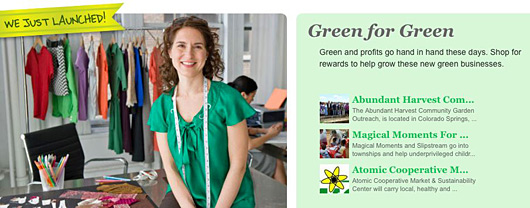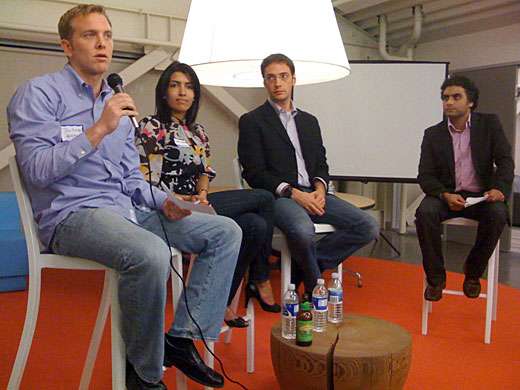The post How nonprofits can use crowdsourcing to work smarter and save money appeared first on Socialbrite.
]]>
Greenfunder funds socially responsible projects and businesses.
Target audience: Nonprofits, social enterprises, NGOs, foundations, businesses, educators. This is part one of a two-part series on crowdsourcing.
By Lindsay Oberst
Socialbrite staff
 High-quality work at a low cost. That’s what crowdsourcing can achieve for nonprofts that wish to save money while pursuing their mission.
High-quality work at a low cost. That’s what crowdsourcing can achieve for nonprofts that wish to save money while pursuing their mission.
Crowdsourcing refers to harnessing the skills and enthusiasm of those outside an organization who are prepared to volunteer their time contributing content or skills and solving problems, sometimes for free, sometimes for a fee. An offshoot, crowd funding, describes the collective efforts to pool their money together on behalf of a cause, project or business. Kiva (loans to entrepreneurs), Crowdrise and Kickstarter (raise funds for creative projects) and Greenfunder, which launched in May as a site to raise funds for socially responsible projects and businesses, are among the burgeoning number of crowd funding sites. (See a few others in our roundup of 24 tools for fundraising with social media.)
Crowdsourcing, a bit of a catch-all term, can be used to gather information, solicit advice, save money or get stuff done. It can also help to inform decisions, demonstrate inclusiveness and bring a whole new meaning to collaboration.
We’ve seen the rise of community crowdsourcing with the advent of social media, but it’s always been part of the way society works. And nonprofits have always been at the forefront of crowdsourcing long before the term was coined in 2006. The idea simply fits in with the way small organizations work.
Here are a few quick, low-key ways crowdsourcing works
Say you’re a nonprofit looking to improve your services. You ask your Facebook fans and Twitter followers — people who have chosen to connect with you — how they think you can become better. They feel included in the process and want to answer, and then your organization has a solution to its problem. That’s what crowdsourcing can do — it can get a job done.

Or take blog posts. Studies show that people respond better to posts with images, so your organization seeks to include a photo along with the information you provide on your website. Where can you find images? Two good starts are Socialbrite’s Free Photos Directory and Flickr’s directory of Creative Commons photos, with 160 million photos available under various licenses. Both can be used to find free photos that you can use for your website, blog posts, reports, presentations and more — just give the photographers proper attribution.
Or maybe you’re wondering if your idea has been tried before — say, if someone has already learned lessons from running a fundraising campaign using Twitter? (Yes.)
Organizations are already using crowdfunding, crowd voting and crowdsourcing to gather information and improve the way they work. You’ll find that there are a handful of companies and services that offer crowdsourcing as their core business, such as CrowdFlower and Amazon’s Mechanical Turk, while other companies use crowdsourcing to deliver other services, such as Elance (a marketplace for freelance services), All Our Ideas (a platform for crowdsourced suggestions) and GeniusRocket (a logo and Web design service).
3 examples of nonprofits using crowdsourcing

Samasource
A number of nonprofits have taken the plunge and begun taking advantage of the new landscape. One of our favorites is Samasource, a nonprofit whose entire model is based on crowdsourcing dignified work to a workforce based in developing nations. Here are three other examples of nonprofits using crowdsourcing.
1All Our Ideas (“a suggestion box for the digital age”). This open source software is free to use and allows viewers to vote on ideas and add their own. Matthew Salganik, who created the project and works in the department of sociology at Princeton University, says it “allows the best ideas to bubble to the top.”
Catholic Relief Services, a nonprofit, is the official international humanitarian agency of the Catholic community in the United States. They wanted to evaluate all the workers in each of their offices around the world. All Our Ideas gave them an internal platform to source ideas from their workers, the people who know best about how everything works.
This idea platform is not limited to nonprofits or work evaluation. Others using it include the New York City Mayor’s Office and The Washington Post, which used it to increase reader participation.
2GeniusRocket (“the first curated crowdsourcing company”). According to GeniusRocket president Peter LaMotte, two forms of popular creative crowdsourcing exist. The first is what 99Designs offers. They outsource logo and Web design services to the public.
The second is what he calls “curated crowdsourcing.” His company creates solutions using vetted professionals and everything is kept private. They began using the first method and then realized some nonprofits didn’t want their messages blasted across the Internet, nor did they want to sort through hundreds of submissions.
“We make it a lot more affordable for nonprofits to source creative marketing content, yet we have a professional community,” LaMotte said.
Nonprofits use GeniusRocket primarily for the creation of videos and customizable content.
3Spot.us. “Community-funded reporting” is the tagline of this crowdsourcing service. United Roots, an Oakland-based nonprofit that uses music to help kids heal and learn entrepreneurial skills, is one example of how crowdsourced reporting can be used to create community-based coverage. Five of their stories were funded through Stories for Good and Spot.us.
For other similar services, see this answer on Quora. The Techsoup.org blog also has some good examples of nonprofits using crowdsourcing services.
As you can see, the possibilities of crowdsourcing are extensive. It still has limits, and it may not be the best solution for every nonprofit or organization, but it’s worth considering in the right circumstances.
Want more crowdsourcing?
- We recently showed our readers on way to crowdsource web design on the cheap.
- Our earlier article about 15 ways to crowdfund a project.
Coming Thursday: Look for our interview with Mollie Allick of CrowdFlower.
Related
• Samasource enables socially responsible outsourcing (Socialbrite)
• Tap into the collective power of your community (Socialbrite)
• Crowdsourcing a presentation at SXSW (Wiser Earth Blog)
• Social good crowdsourcing (Mashable)
• An app to support refugees working in Africa (Socialbrite)
• 10 kickass crowdsourcing sites for your business (Econsultancy)
• 6 Great Crowdsourcing Sites For Freelancers (Sitepoint)
• Crowdfunding: Investment for Good (Care2)
 This work is licensed under a Creative Commons Attribution 3.0 Unported.
This work is licensed under a Creative Commons Attribution 3.0 Unported.
The post How nonprofits can use crowdsourcing to work smarter and save money appeared first on Socialbrite.
]]>The post Crowdflower: Toward a world of crowdsourced labor appeared first on Socialbrite.
]]>Crowdflower: Toward a crowdsourced world from JD Lasica on Vimeo.
 One of the most interesting start-ups that keeps popping up on my radar screen is Crowdflower, which connects nonprofits and companies with people around the globe looking to work on crowdsourced tasks.
One of the most interesting start-ups that keeps popping up on my radar screen is Crowdflower, which connects nonprofits and companies with people around the globe looking to work on crowdsourced tasks.
It’s a fascinating glimpse at future contract labor models and at how work relationships are becoming more distributed, global, ephemeral and efficient.
Crowdflower takes simple tasks and breaks them down, using a global network of workers to determine, say, if a tweet about a brand is negative or positive, or if a piece of content violates a site’s community guidelines.
The person might spend 2 minutes on a task, an hour, or more. “The advantage is that the person doesn’t have to drive to work, they don’t even have to sign up for a website. They can just come to a job post, accomplish a task and get paid — in minutes,” says Crowdflower CEO and founder Lukas Biewald.
I spent three minutes chatting with Lukas at an extremely noisy rooftop party at South by Southwest Interactive. The video won’t win any awards for aesthetics — I was being jostled while holding a Kodak Zi8 hi-def camcorder — but it’s evidence that when you meet interesting people, it’s good to have a handheld recorder in your pocket.
Watch, embed or download the video on Vimeo
One mind-blowing angle: You’d be surprised at the number of people willing to perform tasks, such as in a Facebook game, in exchange for virtual currency that can buy them more trees in Zynga’s Farmville or more weapons in Mafia Wars. “People don’t realize how much this virtual money means to people,” he says.
Its website says Crowdflower provides access to an “elastic workforce” of more than a half million workers in over 70 countries — including refugee camps and developing nations where a few dollars go a long way.
As I understand this, CrowdFlower workers (they call them “customers”) complete large-scale jobs on a piecemeal basis in a quick, efficient and inexpensive manner. Similar in some respects to Amazon’s Mechanical Turk, the arrangement is task-based and avoids the need for lead time and overhead associated with traditional hiring and outsourcing.
Samasource, which we’ve written about in here and here, has a similar but somewhat different model that’s focused on ongoing work relationships with specific groups in developing countries.
Both Lukas and Samasource CEO Leila Chirayath were on a panel at the Commonwealth Club this spring that I caught. Crowdlower, Samasource, Ushahidi and FrontlineSMS were also involved in Haiti relief efforts using crowdsourcing and mobile phones, which we wrote about in February.
Related
• Samasource enables socially responsible outsourcing
• Helping Haitians via mobile, crowdsourcing & social media
• An app to support refugees working in Africa
• Harnessing the crowd for social good
 This work is licensed under a Creative Commons Attribution 3.0 Unported.
This work is licensed under a Creative Commons Attribution 3.0 Unported.
The post Crowdflower: Toward a world of crowdsourced labor appeared first on Socialbrite.
]]>The post Harnessing the crowd for social good appeared first on Socialbrite.
]]>
 Last night was another one of those eye-popping events where large numbers of people turn out for an event to discuss how new technologies can be used to advance social change. In this case, about 120 people turned out for Crowdsourcing for social good, sponsored by SocialEarth, and Hub Bay Area and hosted by Chronicle Books and organized by Sundeep Ahuja.
Last night was another one of those eye-popping events where large numbers of people turn out for an event to discuss how new technologies can be used to advance social change. In this case, about 120 people turned out for Crowdsourcing for social good, sponsored by SocialEarth, and Hub Bay Area and hosted by Chronicle Books and organized by Sundeep Ahuja.
The gathering triggered a dozen ideas for future blog posts on Socialbrite, and since I don’t have time today to research all of the sites and initiatives mentioned, I’ll pass along some of the best nuggets:
• I met Leila Janah of Samasource (“computer-based work for women, youth and refugees living in poverty)” at last fall’s Craigslist Nonprofit Bootcamp when her nonprofit was just getting launched. Here’s our earlier interview: Samasource enables socially responsible outsourcing. The goal, she said last night, is to offer “dignified computer-based work to the most marginalized communities in world.” At the moment, Samasource has brought in $210,000 in payments from project leaders to 517 people in six countries, many of whom had been making than $125 a year. (Become a fan of Samasource on Facebook. The event raised $380 for the nonprofit.)
• Jon Bischke, founder of eduFire, talked about his start-up — an open education platform that is pioneering live video education. On the year-old site, more than 5,000 people have signed up to become instructors and 30,000 people take lessons in a wide array of subjects. Based in San Francisco, eduFire has three full-time employees and several part-timers. (Become a fan on Facebook.) See an earlier video interview of Jon produced by DogandPony.com.
• Fun factoid from Bischke: “It took 100 million hours to build Wikipedia, and that’s the same amount of time that Americans spend watching TV in a typical week.”
• I invited Jacob Colker, co-founder of The Extraordinaries, to join me in speaking at Net Tuesday on Sept. 8, and Jacob once again dazzled the audience with accounts of how crowdsourcing can be used for positive social change in your spare time. “The Extraordinaries are here to make it ridiculously easy for you to do social good,” he said. You can translate documents, or identify figures in a painting, or help with science and medical problems, among many other options. (Become a fan on Facebook.)
• Mechanical Turk from Amazon took up a surprisingly large amount of the discussion. It’s a way for people to earn small amounts of money by doing mostly repetitive online chores (with a few exceptions that require creative thinking). According to the latest stats, 76 percent of those who work on Mechanical Turk are from the United States, followed by India (now that Amazon supports payments there), with workers from the Philippines joining at a rapid clip.
Typically, a person signed up for a Mechanical Turk project makes 2 to 6 cents per task. “That’s real income in some of the poorest areas of the world,” Leila said. “I’m shocked at how many cost-conscious start-up CEOs haven’t heard of it,” Jon added.
• Great idea from Leila: “Maybe Amazon should do a Facebook Connect implementation so you can see the real person behind the work [on Mechanical Turk] instead of a faceless entity — an invisible unit of labor.”
• Turkopticon is helping to organize Mechanical Turkers.
“We’re at the beginning of a fascinating time in how we organize human labor,” Jacob said.
True. Much more to come on this subject.
Readings
Recommended reading from last night (at Amazon):
• Crowdsourcing: Why the Power of the Crowd Is Driving the Future of Business
• Here Comes Everybody: The Power of Organizing Without Organizations
• A Whole New Mind: Why Right-Brainers Will Rule the Future
 This work is licensed under a Creative Commons Attribution 3.0 Unported.
This work is licensed under a Creative Commons Attribution 3.0 Unported.
The post Harnessing the crowd for social good appeared first on Socialbrite.
]]>![Reblog this post [with Zemanta]](http://img.zemanta.com/reblog_e.png?x-id=519cd278-c65d-492b-848f-fdeb74b12fc7)